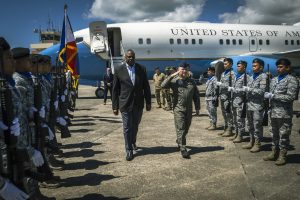U.S. Defense Secretary Lloyd Austin was in the Philippines on Wednesday for talks about deploying U.S. forces and weapons in more Philippine military bases to ramp up deterrence against China’s increasingly aggressive actions toward Taiwan and in the disputed South China Sea.
Austin flew from South Korea, where he said the United States would increase its deployment of advanced weapons such as fighter jets and bombers to the Korean Peninsula to bolster joint training with South Korean forces in response to North Korea’s growing nuclear threat.
In the Philippines, Washington’s oldest treaty ally in Asia and a key front in the U.S. battle against terrorism, Austin visited southern Zamboanga city and met Filipino generals and a small contingent of U.S. counterterrorism forces based in a local military camp, regional Philippine military commander Lt. Gen. Roy Galido said. The more than 100 U.S. military personnel have provided intelligence and combat advice for years to Filipino troops battling a decades-long Muslim insurgency, which has considerably eased but remains a key threat.
More recently, U.S. forces have intensified and broadened joint training focusing on combat readiness and disaster response with Filipino troops in the Southeast Asian nation’s western coast, which faces the South China Sea, and in its northern Luzon region across the sea from the Taiwan Strait.
American forces have been granted access to five Philippine military camps, where they could rotate indefinitely under a 2014 defense pact called the Enhanced Defense Cooperation Agreement.
In October, the United States sought access for a larger number of its forces and weapons in an additional five military camps, mostly in the north. That request would be high on the agenda in Austin’s meetings, according to Philippine officials.
“The visit of Secretary Austin definitely, obviously will have to do with many of the ongoing discussions on the EDCA sites,” Philippine Ambassador to Washington Jose Romualdez said at a news briefing.
Austin was scheduled to hold talks Thursday with his Philippine counterpart, Carlito Galvez Jr., and National Security Adviser Eduardo Ano, Romualdez said. Austin will separately call on President Ferdinand Marcos Jr., who took office in June and has since taken steps to boost relations with Washington.
The U.S. defense chief is the latest senior official to visit the Philippines after Vice President Kamala Harris in November in a sign of warming ties after a strained period under Marcos’s predecessor, Rodrigo Duterte.
Duterte had nurtured cozy ties with China and Russia and at one point threatened to sever ties with Washington, kick visiting U.S. forces out, and abrogate a major defense pact.
Romualdez said the Philippines needed to cooperate with Washington to deter any escalation of tensions between China and self-ruled Taiwan — not only because of the treaty alliance but to help prevent a major conflict.
“We’re in a Catch-22 situation. If China makes a move on Taiwan militarily, we’ll be affected — and all ASEAN region, but mostly us, Japan and South Korea,” Romualdez told The Associated Press, referring to the Association of Southeast Asian Nations, the 10-nation regional bloc that includes the Philippines.
The Philippines and ASEAN members Brunei, Malaysia, and Vietnam, along with Taiwan, have been locked in increasingly tense territorial disputes with China in the South China Sea. The United States has been regarded as a crucial counterweight to China in the region and has pledged to come to the defense of the Philippines if Filipino forces, ships, or aircraft come under attack in the contested waters.
The Philippines used to host two of the largest U.S. Navy and Air Force bases outside the American mainland. The bases were shut down in the early 1990s after the Philippine Senate rejected an extension, but American forces returned for large-scale combat exercises with Filipino troops under a 1999 Visiting Forces Agreement.
The Philippine Constitution prohibits the permanent basing of foreign troops and their involvement in local combat.

































